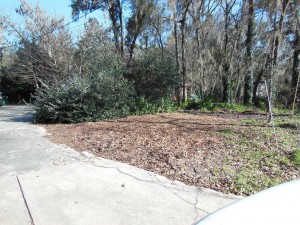Do you have a bare spot that you would like to see go away? How about a problem getting something to grow in a particular area? I’m not talking about that receding hairline or bald spot, I’m talking about your lawns and gardens. Many residents have these problems, whether it is too much shade under our beautiful oaks, that stubborn orange clay, or that hot, dry sand. Often times, the best remedy for these situations is to use mulch. Mulch is a versatile tool in the home landscape that provides many benefits while adding aesthetic beauty.
Some of the benefits of using mulch in your landscape include retaining soil moisture, reducing the amount of weeds, insulating the soil (keeps it warm during cold months and cool during the warm season), improving soil health through decomposition, and protecting plants from mower and/or trimmer damage. In addition, mulch can help protect the quality of local lakes and streams by reducing soil erosion and stormwater runoff. Therefore, not only can it improve your yard, but it can also help minimize impacts to our precious natural resources.
When purchasing mulch, there are many options available. Local lawn and garden shops offer many different types of mulch based on their origin (type of wood the mulch comes from), texture (shredded vs. nuggets), color, and, of course, cost. When considering these options, here is some information to help you choose:
- Origin. Cypress mulch comes from the harvesting of natural cypress wetlands and it not recommended by the University of Florida Florida-friendly Landscaping Program. Pine bark mulch is produced from the paper/pulp industry as a marketable byproduct. Pine needle mulch is harvested from pine tree farms as the trees mature to harvestable size.
- Plant Needs. Pine mulch (either bark or needles) can lower the pH of your soils as it breaks down over time. This is great for acid-loving plants such as azaleas, gardenias, and blueberries, but may affect species that require a high pH.
- Texture. The coarser the texture, the longer the mulch will last. Finely shredded mulches breakdown quicker than coarse mulches, such as bark nuggets. As the mulch breaks down, it adds organic content to your soil, thus improving soil health.
If you want to save money, you can often contact local tree trimming companies for their hard day’s work. As they trim or remove trees, the smaller material is shredded into mulch and they are often willing to drop it off in your yard instead of paying for its disposal. It is best to allow this freshly shredded mulch to cure for some time before placing it in your garden beds since freshly shredded mulch can temporarily reduce the availability of nitrogen in the soil.
When using free mulch options, be aware that weed seeds may be present.
Be sure to apply the mulch in a two to three inch layer in your landscape beds or around trees and shrubs. It’s not a bad idea to aerate any old mulch already present to prevent matting or compaction. This can be done with a rake or pitchfork.
So cover up that soil to improve the look and fertility of your landscapes and to reduce erosion and stormwater runoff. If you have any questions about mulch, more information is available at the Florida-Friendly Landscaping website: http://fyn.ifas.ufl.edu.
- A Tale of Two Hoses - November 13, 2025
- Anthracnose and Aster Yellowing Diseases Recently Diagnosed - August 28, 2025
- Let Extension Diagnose Your Landscape Issues - May 28, 2025
